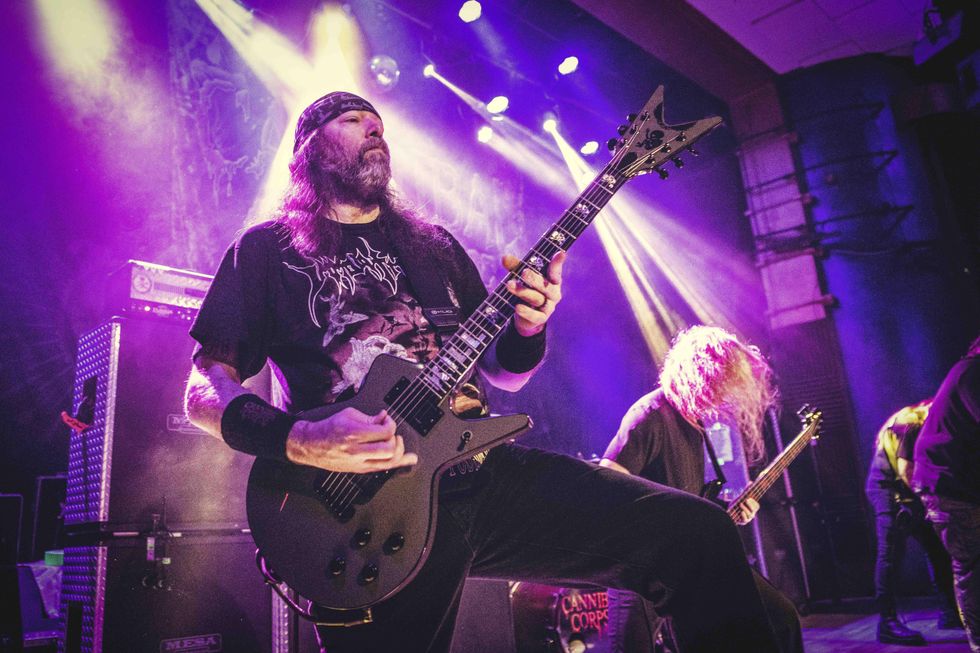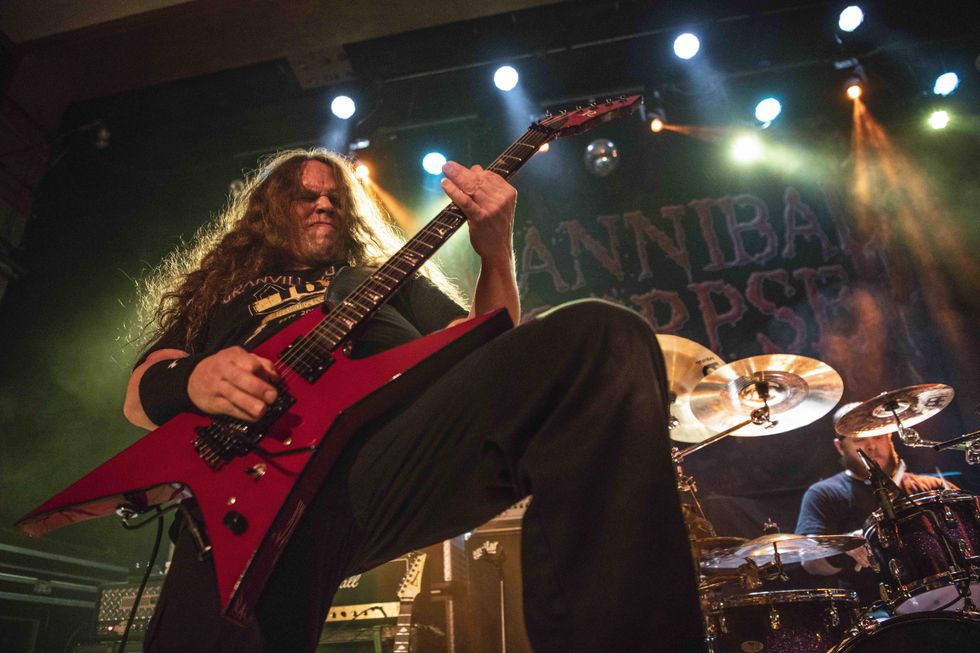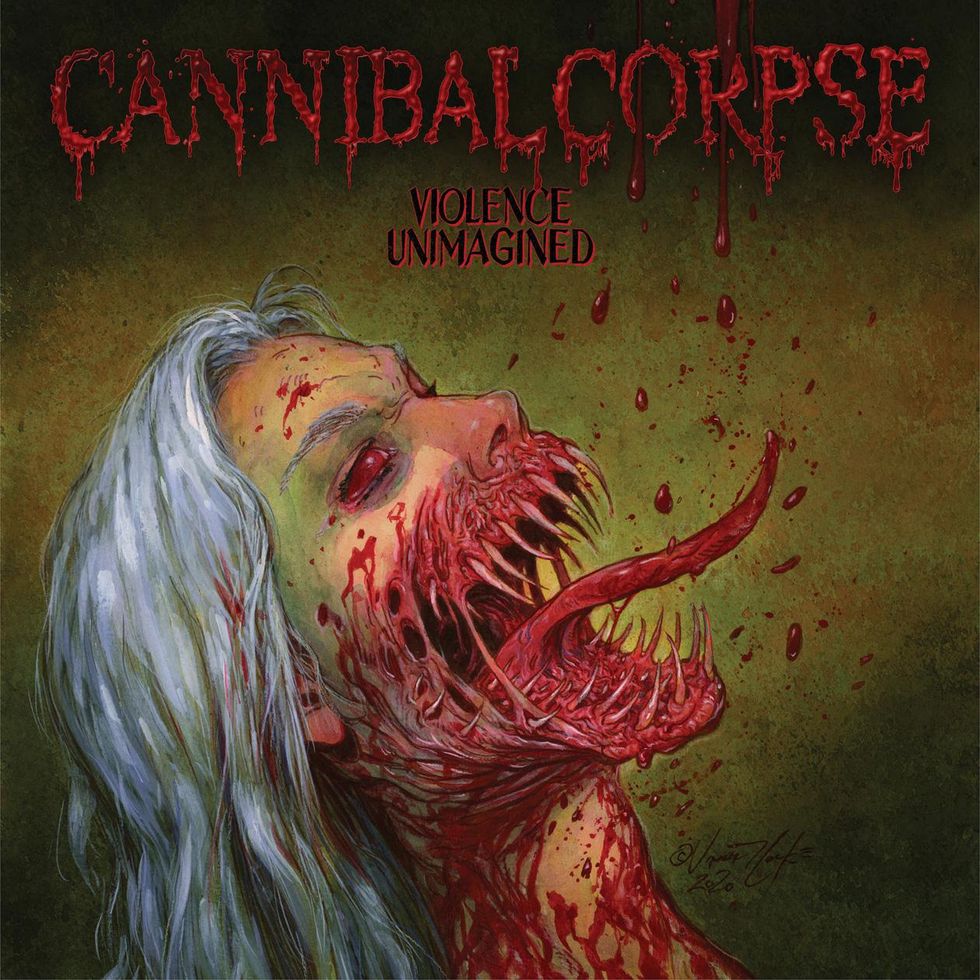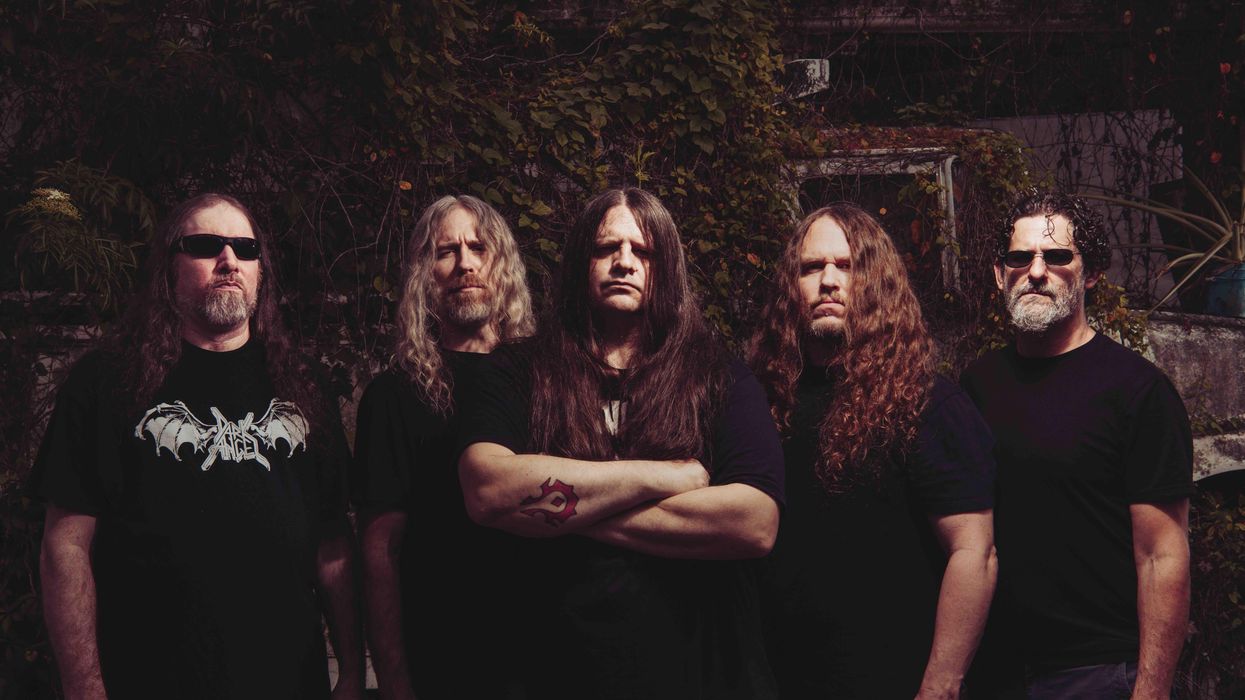As extreme metal continues to splinter into infinite niche genres and thrash metal's heroes steadily mosh towards the pastures of classic rock, it's the right time to re-examine the legacy of the bands that initiated metal's big push towards the outer reaches of its sonic margins. Much of the guitar content on social media these days is comprised of young players shredding and djenting away on extended-scale guitars, and it's no exaggeration to say that none of that would exist without the influence of O.G. American death metal's bludgeoning chug and churn. And while they weren't the first on the scene, Cannibal Corpse is often considered the band that ultimately defined the subgenre's sound.
With the release of their skull-shatteringly heavy 15th studio album, Violence Unimagined—and now boasting over 30 years of parent-terrifying music—Cannibal Corpse have proven yet again that they're more than just innovators within a subgenre. They're an institution. Essentially, Cannibal Corpse is the AC/DC of death-metal: a band that's created a distinct sound and consistently progressed within that idiom despite several lineup changes, including a lead vocalist—again like AC/DC—without sacrificing the elements that made that sound so enthralling in the first place.
Violence Unimagined is a dynamic and bloody disgusting journey through a hectic mix of Cannibal Corpse's signature breakneck blasters and hulking mid-tempo groovers. It's an album that has everything fans love and expect from the Florida-based squad. It's also an album that benefits tremendously from an injection of fresh creative blood via the contributions of longtime producer Erik Rutan, who not only produced the recordings, but officially joined the quintet as a guitarist and songwriter just before starting pre-production.
"I think he did a really good job of adapting and Cannibalizing his riffs to make it sound like us." —Rob Barrett
Best known for fronting his own band, Hate Eternal, and for the multiple long stints he's served on guitar with Morbid Angel, Rutan has spent the lion's share of the past decade producing a laundry list of diverse and critically acclaimed heavy albums from his MANA Studios in St. Petersburg, Florida. This isn't the first time that Rutan has played guitar with the band, though. When Pat O'Brien took leave in 2019, the producer was the obvious choice to step in as his touring replacement. O'Brien and the band have since parted ways entirely, and with Rutan on board as an official member of the group, Violence Unimagined is Cannibal Corpse's first release to feature his song contributions.
A lineup shift can throw a serious wrench in the works for a band with a sound as well-defined as that of Cannibal Corpse, but Rutan's integration into the fold for Violence Unimagined was seamless—something he and guitarist Rob Barrett credit to his deep ties with the group. Rutan details just how deep that history really goes, saying, "I remember Alex [Webster, bass] and Paul [Mazurkiewicz, drums] handing me the first Cannibal record before it even came out! I've known Rob and George ["Corpsegrinder" Fisher, vocals] since 1990, and having recorded the band so many times, I have a really clear understanding of their music. And as guitarists, Rob and I have always worked great together on getting tones and I've always had so much respect for the kind of player and writer he is."
For years now, Cannibal Corpse's songs have been penned by individual band members. Even though Rutan was asked to join just three months before entering the studio, "they welcomed me with open arms when it came to contributing songs," he says. "A lot of Alex's and Rob's songs had been formulated already when I started to write, so I was able to see what would help fill in some gaps to help make it an even bigger album dynamically. I had a very loose thought process going into it because there had been songs presented to me already, and I was working around those, though when I typically start writing, thinking kind of goes out the window. The songwriting is more about instinct and trying to preserve the things that make this band what it is, while still creating fresh ideas. I think that's why this band has had the success and longevity it has, and I love every record this band has done because they all offer something unique."
Rob Barrett's Gear

"It's crazy to think, but we're almost classic death metal now," says Rob Barrett, seen here playing his Dean Cadillac onstage with Cannibal Corpse in 2018.
Photo by Alex Morgan
Guitars
- 1989 Gibson Les Paul Standard with EMG 81 pickups
- Dean Custom Shop Cadillac with 25 ¾" scale and Fishman Fluence Modern Active Humbuckers
- Charvel Pro-Mod So-Cal Style 1 HH with maple fretboard and Seymour Duncan JB pickups (used for solos)
Strings and Picks
- D'Addario NYXL (.011–.064 7-string sets, without the .011, for guitars tuned to G# and C#)
- D'Addario NYXL (.013-.056, for guitars tuned to A# and D#)
- Dunlop Tortex 1.5 mm Sharp
Amps
- Mesa/Boogie Dual Rectifier
- Peavey 5150 (block letter era)
- Vintage Marshall JCM800
- Marshall 4x12 cab with Celestion Greenbacks
Effects
- Ibanez 30th Anniversary TS9 Tube Screamer
- Maxon OD-9 Overdrive
- Maxon ST-9 Pro+ Super Tube
Despite their longstanding rapport and mutual respect, Barrett admits he was a bit apprehensive about adding Rutan to the mix as a songwriter. "I was worried his songs were going to sound too much like Hate Eternal, but when he started playing me his stuff, it was like, 'Wow! This does sound like Cannibal Corpse!' You could just tell Erik Rutan wrote them. He did a really good job of adapting and Cannibalizing his riffs to make it sound like us." To Rutan's credit, he says writing tunes for Violence Unimagined felt "very natural," not only because of his long history with the group, but as a fan the guitarist felt confident he could apply his own feel and musical stamp to Cannibal Corpse's songs.
The major pivot point from past Cannibal Corpse releases comes from Rutan's unique vocabulary as a soloist. While Barrett's more traditionally stout shredding remains an immediately recognizable part of the Cannibal Corpse sound, Rutan's slithering melodic playing is worlds away from the chaotic chromatics of predecessor O'Brien. Rutan says, "Some of my earliest memories are hearing different composers, like Beethoven, Bach, Mozart, Vivaldi.... I really feel like listening to classical music as a child influenced how I approach songwriting. Even the stuff that's more dissonant has a classical background that I personally hear really clearly. The solo on 'Follow the Blood' is one of those moments. I created a melody, and halfway in it goes into a harmonized counterpoint melody, and in the center of the stereo spread is a full-on solo lead. That solo has a real classical music approach."
"Some of my earliest memories are hearing different composers, like Beethoven, Bach, Mozart, Vivaldi …" —Erik Rutan
The guitarist also looks well beyond Western classical music, and adds, "Turkish music and Middle Eastern stuff has been a huge inspiration to me! Listening to a lot of Middle Eastern music inspires a lot of my solos, even in 'Inhumane Harvest,' where there's slides and half-tone things that have a Middle Eastern flavor. And I do like to do a little shred here and rippin' there, but the song has to call for that."
Drawing from such a wide range of source material provides Rutan with the substance required to fulfill his own mission as a soloist. "I've always looked at solos as a journey within songs, and they have to take a path," he says. "It's all about the solo feeling natural within a song, and I want them to make an impact. If you look back at everything I've done, from Ripping Corpse to Morbid Angel and Hate Eternal, my approach to soloing has always been about substance over flash. It's never been about technique as much as it's been about feel, but with complexity. To me, complexity and technique are very different things."
Erik Rutan's Gear

Here's Erik Rutan onstage with his B.C. Rich Ironbird, back when Hate Eternal toured as an opening act for Cannibal Corpse in 2018.
Photo by Alex Morgan
Guitars
- 1989 Gibson Les Paul Standard w/ EMG 81 pickups
- B.C. Rich Custom Shop Ironbird w/Gibson Dirty Fingers bridge pickup and Lawrence L-500 neck pickup (used for solos)
Strings and Picks
- D'Addario NYXL (.11–.64 7-string sets, without the .011, for guitars tuned to G sharp and C sharp)
- D'Addario NYXL (.13-.56, for guitars tuned to A sharp and D sharp)
- Dunlop Jazz III XL Tortex 1.35 mm
Amps
- Mesa/Boogie Dual Rectifier
- Peavey 5150 (block letter era)
- Vintage Marshall JCM800
- Marshall 4x12 cab with Celestion Greenbacks
Effects
- Ibanez 30th Anniversary TS9 Tube Screamer
- Maxon OD-9 Overdrive
- Maxon ST-9 Pro+ Super Tube
While Violence Unimagined certainly marks a new era in many ways for Cannibal Corpse, it's business as usual for Barrett, who reflects on the band's legacy: "It's crazy to think, but we're almost classic death-metal now! We, as a band, have tried really hard to stay on the track we started on while moving forward. We never want to be stuck in the past and just keep trying to copy what we already did."
Meanwhile, Rutan ruminates on the process a bit more sentimentally. "Everyone's contributions and the accumulation of everyone's unique approach has allowed this band to keep progressing over the course of 15 albums, but those albums all keep true to the essence and spirit of what Cannibal Corpse is. From the riffs to the solos to the song structures to the album flow, it's all a journey.
Stacking Up Corpses: Building the Band’s Rhythm Guitar Sound

Longtime producer Erik Rutan stepped into the guitar chair on Violence Unimagined, marking his first time as a songwriter for the band.
After working on five albums with the band, Rutan may have mastered the clandestine art of recording Cannibal Corpse, but that doesn't mean it's an easy gig. The producer is adamant about quad-tracking rhythm guitars, a technique he says is key to creating the brutal wall of chainsaw axes that is Cannibal Corpse's calling card. Rather than reamping a single performance or splitting the guitar signal to multiple amps to capture several sources in one take, the two guitarists each had to provide four individual performances of every one of the new album's challenging, often tremolo-picked, rhythm parts.
Rutan breaks down the madness behind the method: "Part of what I like to do is color the four tracks with multiple amps, so we'll start with a defining tone, which will be the main tone panned left and right. Then we find a second tone to add in for the third and fourth tracks, and that tone is not really about how it sounds on its own, but what it contributes to the overall sound when combined with the main tone. We'll have guitar tracks three and four around 5 to 7 dB lower in the mix than the main tracks. You get a different character and dynamic in the overall tone that you don't even know is missing until you add that second amp in."
From Barrett's perspective, the hardest part about the quad tracking process is simply getting through the first track. "As soon as you get to the second track, it gets smoother and you can keep going," he says. "We try to play through each track as far as we can without doing punches, but this stuff isn't easy and we do punch in when it's a tricky part."
Rutan adds, "Rob and I are very proficient at duplicating our performances tightly and that really adds to that wall of sound. When you play a part four times, the little idiosyncrasies and inconsistencies—as long as you're a really tight player—add another layer of dynamics to the guitars."
"If you'd asked me a year ago what I saw coming, I'd have never envisioned how this whole thing unfolded. I've done a lot in my career and I've always felt really grateful for all the opportunities I've had, but this record, especially, is one of my proudest moments. After all these years, to join Cannibal Corpse—a band that means so much to my life, my career, and, personally, as friends—to be a part of it after 30-plus years of playing death-metal … it still blows my mind! It feels great and it feels so natural. I can't help but feel gratitude about it while also reflecting on the ups and downs and the work I've put into everything I do, and to be able to continue that while being a part of Cannibal Corpse is really special for me."
CANNIBAL CORPSE - Live in Bucharest, Romania 13.06.2019 [Full Show]
This raging concert performance from Bucharest, Romania, in 2019 was part of Erik Rutan's first tour with the band, before he became an official full-time member.






















![Rig Rundown: AFI [2025]](https://www.premierguitar.com/media-library/youtube.jpg?id=62064741&width=1245&height=700&quality=70&coordinates=0%2C0%2C0%2C0)




















 Zach loves his Sovtek Mig 60 head, which he plays through a cab he built himself at a pipe-organ shop in Denver. Every glue joint is lined with thin leather for maximum air tightness, and it’s stocked with Celestion G12M Greenback speakers.
Zach loves his Sovtek Mig 60 head, which he plays through a cab he built himself at a pipe-organ shop in Denver. Every glue joint is lined with thin leather for maximum air tightness, and it’s stocked with Celestion G12M Greenback speakers.











